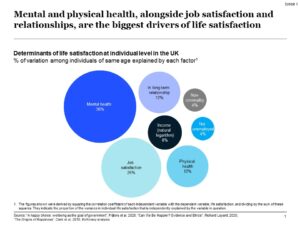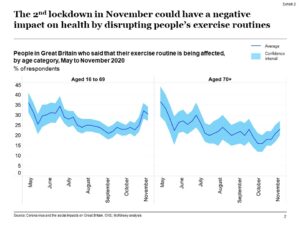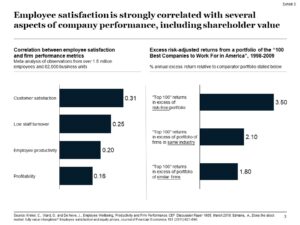Is employee wellbeing the most important contribution businesses can make to society?
Protecting lives and livelihoods – that is the new mantra as the world grapples with the coronavirus pandemic. Yet, there’s a third ‘L’ that also needs urgent attention: life satisfaction.
As the COVID-19 crisis started to bite in the second quarter of 2020, life satisfaction ratings in Great Britain dropped to an average of 7.0, compared to 7.7 in the 2nd quarter of the preceding 5 years. Even though the figures are not strictly comparable, this is an enormous change, corresponding to around a third of a standard deviation in typical life satisfaction surveys. By way of a crude illustration, the effect is larger than that of everyone in Britain losing their jobs or getting separated from their partner!
In a recent McKinsey.com article, we estimated that the pandemic’s negative impact on well-being in April 2020 across Europe was up to 3.5 times the losses experienced in GDP – which, in turn, were the worst we have seen since the Second World War. This comparison makes clear that the consequences for life satisfaction are at least as important as those for livelihoods.
Study after study has found that mental and physical health trump money and employment when it comes to individuals’ happiness (see Exhibit 1).

Across all areas of life, there are reports of people feeling anxious, stressed, overwhelmed and burned out. In ONS’s regular weekly survey, more than 70% of people were “very worried” or “somewhat worried” about the situation. When it comes to physical health a significant proportion of people are saying that their exercise routine is being disrupted (see Exhibit 2).

So, as society battles with such huge challenges, what is the role of business?
A lot of focus has been on how businesses can help save lives, by keeping employees safe, finding solutions such as vaccines or sustaining as many jobs as is feasible. These aims are vital, of course, but focus also needs to extend to the third ‘L’: life satisfaction.
Leaders and managers have a critical role to play here. We know the importance of job satisfaction for people’s overall happiness. Further research reveals that the lion’s share of this is determined by workplace relationships.
COVID-19 has put these relationships under the spotlight – in just a very short period, the time and means by which we have to connect with the people we work with has changed dramatically, and as such so has the quality of those interactions.
It is important to protect and invest in workplace relationships. Research undertaken by the Department of Business, Innovation and Skills highlights that ‘positive relationships with managers, co-workers and customers’ are key characteristics of ‘good jobs’ that enhance workers wellbeing and engagement, and improve organisational performance. Similarly, the What Works Centre for Wellbeing’s ‘high quality job’ framework refers to the relevance of the social connections we have.
The crux of the matter is this: companies serious about their environmental, social and governance (ESG) agenda cannot ignore employee happiness. And if they did, their shareholders should ask some serious questions; after all, satisfied employees are a key ingredient in securing customer loyalty, profitability and growth (see Exhibit 3). Improving staff engagement and satisfaction is a clear win-win for both shareholders and society.

So as a manager, how can you turn this evidence into action?
- Be aware of the importance of job quality for wellbeing
- Find out what staff see as important for improving the quality of their work
- Make sure that line and middle managers are committed to improving jobs
- Take the action which will best fit the needs of staff and circumstances
